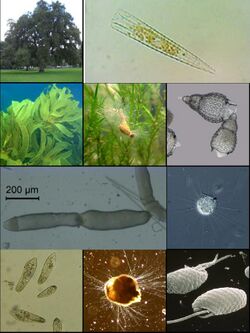Biology:Plants+HC+SAR megagroup
| Plants+HC+SAR megagroup | |
|---|---|

| |
| Scientific classification | |
| Domain: | Eukaryota |
| Clade: | Diaphoretickes |
| unranked groups | |
| Synonyms | |
| |
The Archaeplastida+HC+SAR megagroup is a group of eukaryotes proposed by Burki et al. (2008).[1] It is also referred to as Diaphoretickes (/ˌdaɪəfəˈrɛtɪkiːz/) or the SAR/HA Supergroup, or the Corticata with Rhizaria.[2]
It includes:
- Archaeplastida (comprising the plants, red algae, green algae, and glaucophytes)
- Hacrobia (the "HC" refers to Haptista and Cryptista, the two basal clades in the group)
- SAR supergroup (consisting of stramenopiles+alveolates+Rhizaria)
According to this description, it includes most of the species engaging in photosynthesis, except for the Euglenozoa and Cyanobacteria. It includes all Bikonts that are not excavates and Hemimastigophora.
The name "Corticata" comes from Cavalier-Smith's hypothesis about the common origin of the cortical alveoli of glaucophytes and alveolates.[3]
The megagroup was previously described as the sum of Archaeplastida, Rhizaria, and chromalveolates.[4] However, this description is obsolete, largely due to the discovery that chromalveolata is not monophyletic.
References
- ↑ Burki, F.; Shalchian-Tabrizi, K.; Pawlowski, J. (2008). "Phylogenomics reveals a new 'megagroup' including most photosynthetic eukaryotes". Biology Letters 4 (4): 366–369. doi:10.1098/rsbl.2008.0224. PMID 18522922.
- ↑ Cavalier-Smith, Thomas; Chao, Ema E.; Snell, Elizabeth A.; Berney, Cédric; Fiore-Donno, Anna Maria; Lewis, Rhodri (2014). "Multigene eukaryote phylogeny reveals the likely protozoan ancestors of opisthokonts (animals, fungi, choanozoans) and Amoebozoa". Molecular Phylogenetics and Evolution 81: 71–85. doi:10.1016/j.ympev.2014.08.012. ISSN 10557903. PMID 25152275.
- ↑ Cavalier-Smith, Thomas (January 2003). "Protist phylogeny and the high-level classification of Protozoa". European Journal of Protistology 39 (4): 338–348. doi:10.1078/0932-4739-00002. https://linkinghub.elsevier.com/retrieve/pii/S093247390470108X.
- ↑ Hampl, V.; Hug, L.; Leigh, J.; Dacks, J.; Lang, B.; Simpson, A.; Roger, A. (2009). "Phylogenomic analyses support the monophyly of Excavata and resolve relationships among eukaryotic "supergroups"". Proceedings of the National Academy of Sciences of the United States of America 106 (10): 3859–3864. doi:10.1073/pnas.0807880106. PMID 19237557. Bibcode: 2009PNAS..106.3859H.
Wikidata ☰ Q4589415 entry

